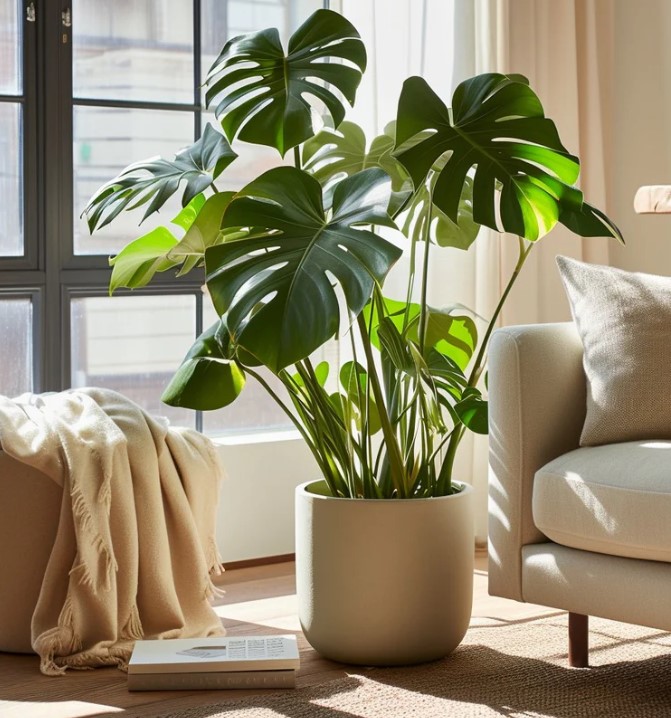If you’re a fan of indoor greenery, you’ve likely encountered the Philodendron Monstera, commonly known as Monstera deliciosa. This iconic plant, also called the Swiss Cheese Plant, is celebrated for its striking, perforated leaves and easy-care nature. Whether you’re a seasoned plant parent or a novice, Monstera deliciosa is a fantastic choice for adding a touch of the tropics to your home
Origins and Natural Habitat
Native to the tropical rainforests of Central America, Monstera deliciosa thrives in warm, humid environments. In the wild, it’s a climbing plant, using its aerial roots to ascend trees in search of sunlight. Its iconic fenestrated leaves are not just for show; they help the plant withstand heavy rainfall and allow light to reach the lower foliage.
Why Is It Called “Deliciosa”?
The “deliciosa” in its name refers to the plant’s edible fruit, which has a unique flavor profile described as a blend of pineapple, banana, and mango. However, the fruit is rarely produced indoors and can only be consumed when fully ripe, as unripe fruit contains calcium oxalate crystals that can irritate the mouth and throat.

Care Tips for Monstera Deliciosa
Caring for a Monstera deliciosa is relatively straightforward, making it a popular choice for both beginners and experienced plant enthusiasts.
1. Light
Monsteras prefer bright, indirect light. Direct sunlight can scorch their leaves, while too little light may prevent their signature holes from forming. A spot near a north- or east-facing window is ideal.
2. Watering
Water your Monstera when the top 2-3 inches of soil feel dry. Overwatering can lead to root rot, so ensure your pot has proper drainage. Reduce watering frequency during the winter months when the plant’s growth slows down.
3. Humidity
As a tropical plant, Monstera deliciosa loves humidity. If your home has dry air, consider misting the leaves or placing a humidifier nearby. Grouping it with other plants can also boost local humidity levels.
4. Soil and Fertilizer
Monsteras thrive in well-draining, nutrient-rich soil. A mix of potting soil, peat moss, and perlite works well. Feed the plant with a balanced liquid fertilizer every 4-6 weeks during the growing season (spring and summer).
5. Pruning and Support
Regular pruning keeps your Monstera looking its best. Remove yellowing or damaged leaves and trim back overgrown stems. Since Monsteras are climbers, providing a moss pole or trellis can help them grow upright and mimic their natural habitat.
Propagation
Propagating Monstera deliciosa is easy and rewarding. Here’s how to do it:
- Take a cutting with at least one node and one healthy leaf.
- Place the cutting in water or directly into moist soil.
- If propagating in water, wait for roots to grow to at least 2 inches before transplanting into soil.
Decorating with Monstera Deliciosa
The Monstera’s large, dramatic leaves make it a statement piece in any room. Use it as a focal point in your living room or pair it with smaller plants for a lush, layered look. Its timeless aesthetic complements various interior styles, from modern minimalism to boho chic.
Why Choose the Philodendron Monstera (Monstera Deliciosa)?
The Philodendron Monstera, also known as Monstera Deliciosa or the Swiss Cheese Plant, is a favorite among plant enthusiasts for its striking and iconic foliage. Its large, glossy green leaves with dramatic splits and holes create a bold, tropical vibe that instantly enhances any indoor space. This fast-growing plant is surprisingly easy to care for, thriving in bright, indirect light and tolerating a range of conditions, making it perfect for both beginners and experienced plant lovers. Beyond its aesthetic appeal, the Monstera Deliciosa also helps improve air quality, contributing to a healthier living environment. Its versatility allows it to grow as a statement floor plant or climb on a moss pole for a vertical display. If you’re looking for a plant that combines beauty, ease of care, and a touch of jungle charm, the Philodendron Monstera is an excellent choice.
